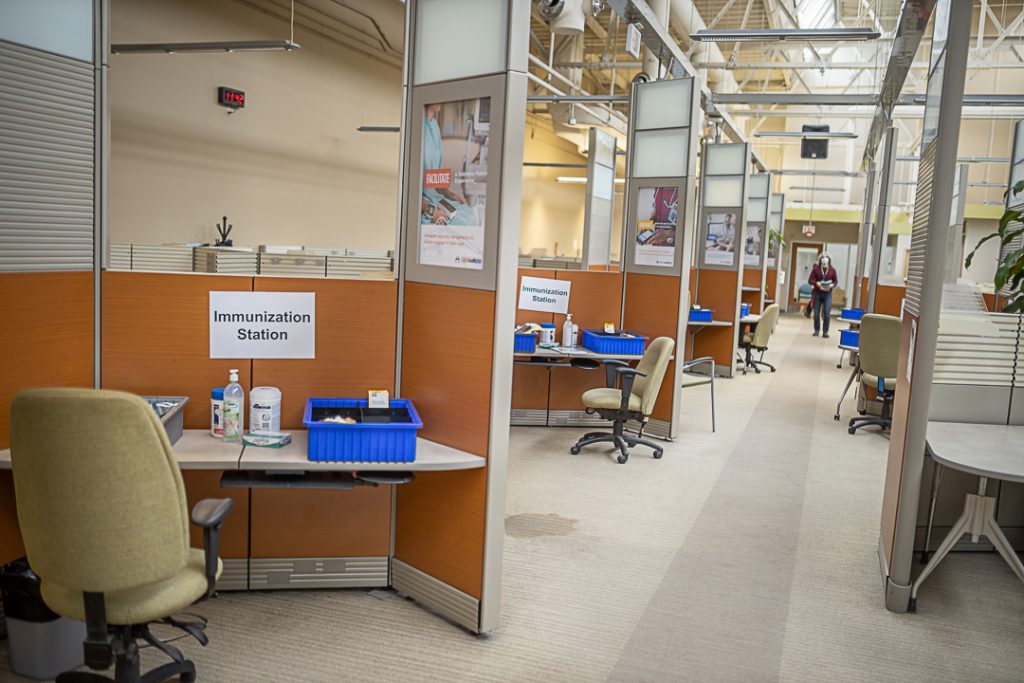
COVID-19 vaccines bring optimism and hope
In late 2020, communities around the world started to see light at the end of the tunnel. Shortly after COVID-19 vaccines arrived in Canada, the Province began distributing allotments to Ontario municipalities. On December 23, the first doses of the Pfizer-BioNTech vaccine were administered to approximately 30 of the city’s long-term care workers. Hope was on the horizon.
While there were ebbs and flows in clinic appointments as vaccine supply fluctuated, Ontario saw vaccine allotments more than triple to 150,000 doses in mid-February. HHS was able to schedule vaccine appointments for more staff, physicians and learners in the highest priority sequence– those most directly at risk for exposure to COVID within the hospital such as workers in COVID units, emergency departments and intensive care units.
“We have an extremely organized and streamlined process in the clinic which helps to create a positive and welcoming atmosphere for patients,” says Dr. Kuldeep Sidhu, Chief of Emergency Medicine at HHS who helped to get the vaccine clinic, and earlier, the COVID-19 Assessment Centre, off the ground.
“I, along with the interdisciplinary staff in the clinic, are so proud to be a part of the great work being done at the vaccine clinic.”
A day in the life
Staff in Hamilton’s COVID-19 vaccination clinic start their day with a team huddle each morning. Those who are returning staff go to their post.
Others who are new to the role get acquainted with their responsibilities. For vaccinators, this includes software training and shadowing a colleague before performing vaccinations themselves.
When you enter the vaccination clinic, there is a check-in and consent process and someone directing people to the next available vaccinator. Once a person receives their vaccine, they go to a waiting area where they are monitored for 15 minutes for any ill effects, and then directed to check-out. At check-out, they are given a receipt as proof they have been vaccinated that day, and confirm their next appointment to receive the second dose.
All patients and healthcare workers at the clinic wear a hospital-grade mask and follow distancing protocols.
It sounds simple, but clinic operations involved a lot of planning and partnerships between Hamilton Health Sciences, St. Joseph’s Healthcare Hamilton, Hamilton Public Health, primary care groups and Hamilton Paramedic Services to get the clinic up and running so smoothly.
“It’s really well organized,” says Ingrid St. Pierre, one of the vaccinators who volunteered to work in the clinic while her usual role as a nurse navigator on the mobile cancer screening coach is paused during the pandemic.
“It’s a happy place,” she says.
Positive atmosphere
Heath care workers and essential caregivers in long-term care homes, retirement homes, and other congregate care settings for seniors were the first priority group as per the framework developed by the Province of Ontario. As of mid-March, a total of nearly 40,000 doses have been administered by clinic staff and physicians.
Emergency physician Dr. Paul Miller works at the clinic, and has also been involved in administering the vaccine in long-term care homes. On Miller’s first day, St. Pierre showed him the way as they worked together in the same pod. While giving the injection isn’t difficult for healthcare workers, it takes a few minutes to learn the software and patient tracking involved.
For both St. Pierre and Miller, the experience at the clinic is enjoyable.
In fact, both described the clinic as “positive and upbeat” in separate interviews.
“It almost seems unique in healthcare that people are happy to come into a clinic. It’s a nice change,” says Miller, who says it’s an honour to be able to provide these vaccinations.
“It really feels like a major step toward knocking this virus on the head.”
Team effort
The clinic brings together all sorts of health professionals who are working to vaccinate hundreds of people each day.
“It was fascinating meeting everybody and asking them what department they’re from,” says St. Pierre. “It’s a mix of all different individuals.”
Most of all, the clinic offers hope.
“2021 is an optimistic year, knowing the vaccine is here,” says St. Pierre.
“There’s hope.”






